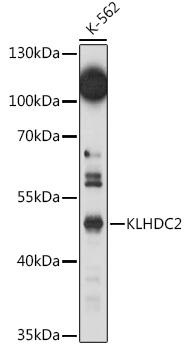Product Name :
KLHDC2 polyclonal antibody Background :
Substrate-recognition component of a Cul2-RING (CRL2 E3 ubiquitin-protein ligase complex of the DesCEND (destruction via C-end degrons pathway, which recognizes a C-degron located at the extreme C terminus of target proteins, leading to their ubiquitination and degradation. The C-degron recognized by the DesCEND pathway is usually a motif of less than ten residues and can be present in full-length proteins, truncated proteins or proteolytically cleaved forms. The CRL2(KLHDC2 complex specifically recognizes proteins with a diglycine (Gly-Gly at the C-terminus, leading to their ubiquitination and degradation. The CRL2(KLHDC2 complex mediates ubiquitination and degradation of truncated SELENOK and SELENOS selenoproteins produced by failed UGA/Sec decoding, which end with a diglycine. The CRL2(KLHDC2 complex also recognizes proteolytically cleaved proteins ending with Gly-Gly, such as the N-terminal fragment of USP1, leading to their degradation. May also act as an indirect repressor of CREB3-mediated transcription by interfering with CREB3-DNA-binding. Product :
1mg/ml in PBS with 0.02% sodium azide, 50% glycerol, pH7.2 Storage&Stability :
Store at 4°C short term. Aliquot and store at -20°C long term. Avoid freeze-thaw cycles. Specificity :
Unmodification Immunogen :
Recombinant fusion protein of human KLHDC2(NP_055130.1). Conjugate :
Unconjugated Modification :
Unmodification
KLHDC2 polyclonal antibody Background :
Substrate-recognition component of a Cul2-RING (CRL2 E3 ubiquitin-protein ligase complex of the DesCEND (destruction via C-end degrons pathway, which recognizes a C-degron located at the extreme C terminus of target proteins, leading to their ubiquitination and degradation. The C-degron recognized by the DesCEND pathway is usually a motif of less than ten residues and can be present in full-length proteins, truncated proteins or proteolytically cleaved forms. The CRL2(KLHDC2 complex specifically recognizes proteins with a diglycine (Gly-Gly at the C-terminus, leading to their ubiquitination and degradation. The CRL2(KLHDC2 complex mediates ubiquitination and degradation of truncated SELENOK and SELENOS selenoproteins produced by failed UGA/Sec decoding, which end with a diglycine. The CRL2(KLHDC2 complex also recognizes proteolytically cleaved proteins ending with Gly-Gly, such as the N-terminal fragment of USP1, leading to their degradation. May also act as an indirect repressor of CREB3-mediated transcription by interfering with CREB3-DNA-binding. Product :
1mg/ml in PBS with 0.02% sodium azide, 50% glycerol, pH7.2 Storage&Stability :
Store at 4°C short term. Aliquot and store at -20°C long term. Avoid freeze-thaw cycles. Specificity :
Unmodification Immunogen :
Recombinant fusion protein of human KLHDC2(NP_055130.1). Conjugate :
Unconjugated Modification :
Unmodification
-
 Western blot analysis of extracts of K-562 cells, using KLHDC2 antibody at 1:1000 dilution.
Western blot analysis of extracts of K-562 cells, using KLHDC2 antibody at 1:1000 dilution.
Secondary antibody: HRP Goat Anti-Rabbit IgG at 1:10000 dilution.
Lysates/proteins: 25ug per lane.
Blocking buffer: 3% nonfat dry milk in TBST.
Detection: ECL Basic Kit .
Exposure time: 150s.
Bioworld Biotech only provide peptides for our antibodies and do not provide additional peptide customization services.
Price/Size :
USD 368/1mg/vial
Tips:
For phospho antibody, we provide phospho peptide(0.5mg) and non-phospho peptide(0.5mg).Describe :
Blocking peptides are peptides that bind specifically to the target antibody and block antibody binding. These peptide usually contains the epitope recognized by the antibody. Antibodies bound to the blocking peptide no longer bind to the epitope on the target protein. This mechanism is useful when non-specific binding is an issue, for example, in Western blotting (WB) and Immunohistochemistry (IHC). By comparing the staining from the blocked antibody versus the antibody alone, one can see which staining is specific; Specific binding will be absent from the western blot or IHC performed with the neutralized antibody.Formula:
Synthetic peptide was lyophilized with 100% acetonitrile and is supplied as a powder. Reconstitute with 0.1 ml DI water for a final concentration of 10 mg/ml.The purity is >90%,tested by HPLC and MS.
Storage:
The freeze-dried powder is more stable. For short time at 2-8°C. For long term storage store at -20°C.
Note :
This product is for research use only (RUO only). Not for use in diagnostic or therapeutic procedures.
 KLHDC2 polyclonal antibody
KLHDC2 polyclonal antibody  Datasheet
Datasheet COA
COA MSDS
MSDS SHIP
SHIP